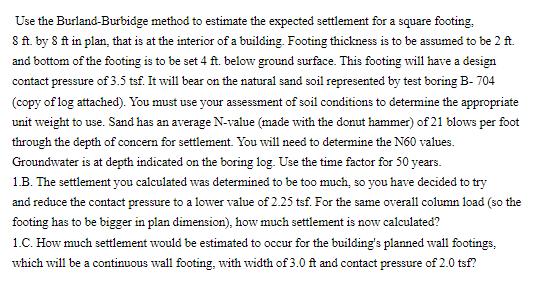Answered step by step
Verified Expert Solution
Question
1 Approved Answer
Use the Burland-Burbidge method to estimate the expected settlement for a square footing. 8 ft. by 8 ft in plan, that is at the

Use the Burland-Burbidge method to estimate the expected settlement for a square footing. 8 ft. by 8 ft in plan, that is at the interior of a building. Footing thickness is to be assumed to be 2 ft. and bottom of the footing is to be set 4 ft. below ground surface. This footing will have a design contact pressure of 3.5 tsf. It will bear on the natural sand soil represented by test boring B- 704 (copy of log attached). You must use your assessment of soil conditions to determine the appropriate unit weight to use. Sand has an average N-value (made with the donut hammer) of 21 blows per foot through the depth of concern for settlement. You will need to determine the N60 values. Groundwater is at depth indicated on the boring log. Use the time factor for 50 years. 1.B. The settlement you calculated was determined to be too much, so you have decided to try and reduce the contact pressure to a lower value of 2.25 tsf. For the same overall column load (so the footing has to be bigger in plan dimension), how much settlement is now calculated? 1.C. How much settlement would be estimated to occur for the building's planned wall footings, which will be a continuous wall footing, with width of 3.0 ft and contact pressure of 2.0 tsf?
Step by Step Solution
There are 3 Steps involved in it
Step: 1
To determine the settlement using the BurlandBurbidge method we will go through the following steps ...
Get Instant Access to Expert-Tailored Solutions
See step-by-step solutions with expert insights and AI powered tools for academic success
Step: 2

Step: 3

Ace Your Homework with AI
Get the answers you need in no time with our AI-driven, step-by-step assistance
Get Started


